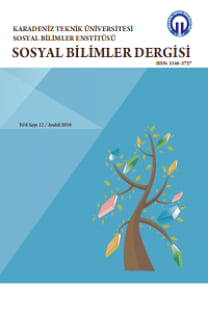Sosyal Hesaplar Matrisi Üzerinden Çarpan Analizi: Türkiye İçin Bir Uygulama
Sosyal Hesaplar Matrisi, Çarpan Analizi, Türkiye
Modeling of Economy With Social Accounting Matrix: An Application for Turkish Economy
Social Accounting Matrix, Multiplier Analysis, Turkey,
___
- Adelman, I., Robinson, S. (1978), Income Distribution Policy in Developing Countries: A Case Study of Korea, Oxford University Press.
- Akkemik, K. Ali (2011), “Potential Impacts of Electrity Price Changes on Price Formation in the Economy: A Social Accounting Matrix Price Modeling Analysis For Turkey”, Energy Policy, 39, 854-864.
- Aydoğuş, Osman (2010), Girdi-Çıktı Modellerine Giriş, 3. Baskı, Efil Yayınevi, Ankara.
- Burfisher, Mary E. (2011), Introduction to Computable General Equilibrium Models, Cambridge University Press, New York, USA.
- Cansino, J.M., Cardenete, M. A., González-Limón, J.M., Román, R. (2014), “The Economic Influence of Photovoltaic Technology on Electrity Generation: A CGE (Computable General Equilibrium) Approach fort he Andalusian Case”, Energy, 73, 70-79.
- Defourny, Jacques, Thorbecke, Erik (1984), “Structual Path Analysis and Multiplier Decomposition within a Social Accounting Matrix Framework”, The Economic Journal, Vol.94, No.373, 111-136.
- Erten, Hakan (2009), Türkiye İçin Sektörel Sosyal Hesaplar Matrisi Üretme Yöntemi ve İstihdam Üzerine Bir Hesaplanabilir Genel Denge Modeli Uygulaması, DPT Uzmanlık Tezleri, Ankara.
- Gül, Zafer Barış (2013), “Türkiye’de 2000 Sonrası Dönemde Kamu Maliyesi Uygulamalarının Bölüşüm Etkilerinin Sosyal Hesaplar Matrisi (SHM) İle Analizi”, Akdeniz İ.İ.B.F. Dergisi, 26, 77-102.
- Güneş, Bayram (2009), “Dünya Ticaret Örgütü Tarım Anlaşmasının Türkiye Ekonomisi Üzerine Etkileri: Bir Hesaplanabilir Genel Denge Modeli Çalışması”, Dokuz Eylül Üniversitesi İktisadi ve İdari Bilimler Fakültesi Dergisi, 24(1), 123-170.
- Hosoe, Nobuhiro (2014), “Estimation Errors in Input-Output Tables And Prediction Errors in Computable General Equilibrium Analysis”, Economic Modelling, 42, 277-286.
- Miller, Wayne P., “Economic Multipliers: How Communities Can Use Them for Planning”, Division of Agriculture, FSCED6.
- Nielson, Chantal Pohl (2002), Social Accounting Matrix for Vietnam 1996 and 1997, Danish Research Institute of Food Economics (FOI), Trade and Microeconomics Division, International Food Policy Research Institute.
- Pyatt, Graham, Round, Jeffery I. (1979), “Accounting and Fixed Price Multipliers in a Social Accounting Matrix Framework”, The Economic Journal, 89, 850-873.
- Pyatt, Graham, Round, Jeffery (1985), Social Accounting: A Basis for Planing, World Bank And Oxford University Press.
- Pyatt, Graham (1988), “A SAM Approach to Modeling”, Journal of Policy Modeling, Volume 10, Issue 3, 327-352.
- Robinson, S. (1988), “Multisectoral Models of Developing Countries: A Survey”, in H. Chenery and T. N. Srinivasan, Handbook of Development Economics, Amsterdam North Holland.
- Roland-Holst, D., Sancho, F. (1992), “Relative Income Determination in the U.S.: A Social Accounting Perspective”, Review of Income and Wealth, 38, 311-327.
- Scandizzo, Pasquale Lucio, Ferrarese, Cataldo (2015), “Social Accounting Matrix: A New Estimation Methodology”, Journal of Policy Modeling, 37, 14-34.
- Tektaş, Metin (2006), Tarımsal Desteklerin Gelir Etkileri: Sosyal Hesaplar Matrisi Uygulaması, (Uzmanlık Tezi), Kamu İktisadi Teşebbüsleri Genel Müdürlüğü Hazine Müsteşarlığı, Ankara.
- Thorbecke, Erik (2000), “The Use of Social Accounting Matrices in Modeling”, Paper Prepared for the 26th General Conference of The International Association for Research in Income And Wealth Cracow, Poland, 1-47.
- Uğurlu, Erginbay (2009), “Sosyal Hesaplar Matrisi (SHM) Üzerine Bir araştırma”, MPRA Paper, Sayı:60344, 1-17.
- Whalley, J., Hillaire, F. S. (1987), “A Microconsistent Data Set for Canada for USe in Regional General Equilibrium for Policy Analysis”, Review of Income and Wealth, 33, 327-343.
- Yeldan, Erinç, Özsan, Mehmet Emin, Taşcı, Kamil (2012), “Türkiye’de İstihdam-Büyüme İlişkisi Üzerine Bölgesel Hesaplanabilir Genel Denge Modeli Uygulaması”, Çalışma ve Toplum, 2012/1, Sayı 32, 11-50.
- Yıldırım, Kenan, Karaman, Doğan, Taşdemir, Murat (2008), Makroekonomi, Seçkin Yayıncılık, Yedinci Basım, Ankara.
- ISSN: 2146-3727
- Yayın Aralığı: 2
- Başlangıç: 2011
- Yayıncı: Karadeniz Teknik Üniversitesi Sosyal Bilimler Enstitüsü
Çalışan Çocukların Sorunları Üzerine Bir Araştırma
TÜRKİYE’DE 1990 SONRASI FİNANSAL KRİZLERİN DIŞ BORÇLARLA İLİŞKİSİNİN ANALİZİ
İktisat Dergilerine Göre Osmanlı Devleti’nin İktisadi Durumu (1857-1923)
Türkiye’de 1990 Sonrası Finansal Krizlerin Dış Borçlarla İlişkisinin Analizi
TEZER ÖZLÜ’NÜN ESERLERİNDE YABANCILAŞMA BAĞLAMINDA GİTME TEMİ
Tezer Özlü’nün Eserlerinde Yabancılaşma Bağlamında Gitme Temi
Saliha AĞAÇ, Serap DENGİN SEVİNİR, Tuğba YILMAZ
6360 SAYILI YASA’NIN YEREL YÖNETİMLER EKONOMİSİ AÇISINDAN DEĞERLENDİRİLMESİ
Saliha AĞAÇ, Serap DENGİN SEVİNİR, Tuğba KİPER YILMAZ
6360 Sayılı Yasa’nın Yerel Yönetimler Ekonomisi Açısından Değerlendirilmesi
